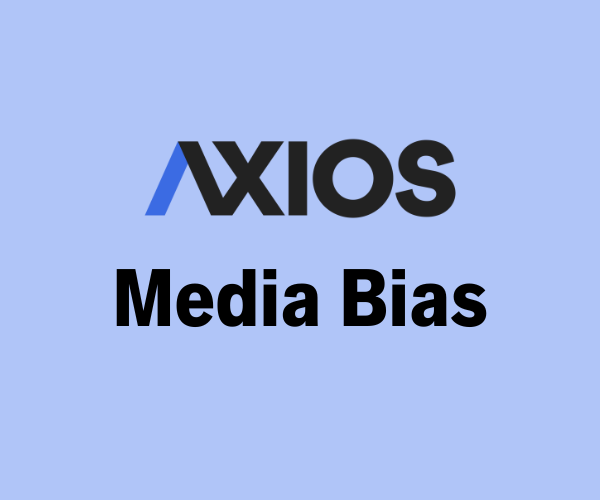
In comparison to its significant news counterparts, Axios is a fairly new outlet. Created in 2016 by 4 former Politico journalists, Axios has progressed as a household name for news. The founders of Axios hoped to create a platform that was a mix between Twitter and The Economist. According to Pew Research, Axios is considered a digital-native news publisher.
Axios’ emergence as a major online news provider creates questions about its possible biases. According to Biasly’s Media Bias Chart, Axios is considered as a “Somewhat Liberal” news outlet.
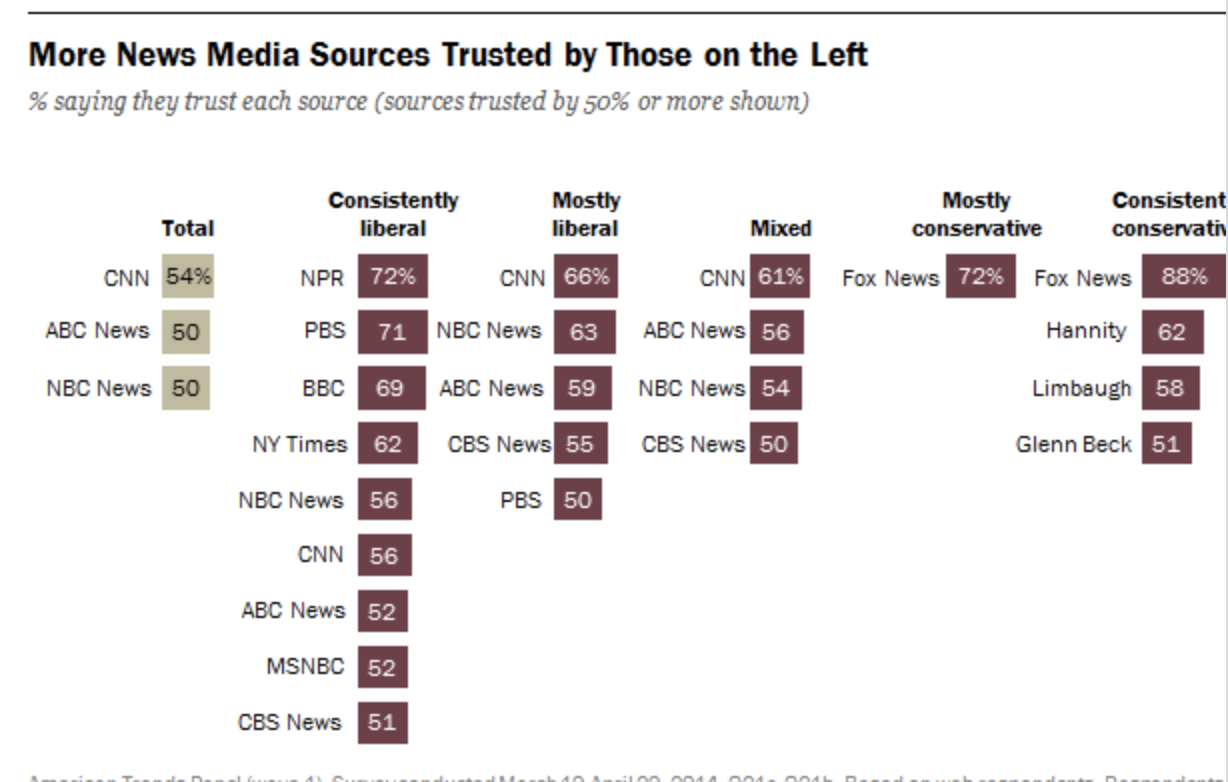
Source: Pew Research
This article will analyze the content of Axios’ publications and explore the possible biases in their reporting. Through this analysis, we hope to find a conclusion on whether Axios has bias.
How Does Biasly Rate News Sources?
Biasly’s algorithms produce bias ratings to help provide multiple perspectives on given articles. Biasly has analyzed 200,000+ news articles from more than 3,200 news sources through our A.I. technology and team of political analysts to find the most factual, unbiased news stories.
Biasly determines the degree of political bias in news sources by using Biasly’s Bias Meter Rating, in which Biasly’s team analyzes media sources’ reliability and bias and produces three scores, a Reliability Score that measures the accuracy of media sources; an A.I. Bias Score, evaluated by A.I.; and an Analyst Bias Score evaluated by political analysts. These scores are rated based on seven rating metrics including Tone, Tendency, Diction, Author Check, Selection/Omission, Expediency Bias, and Accuracy. These metrics help our analysts to determine the political attitude of the article.
Our A.I. machine-learning system employs natural language processing and entity-specific sentiment analysis to examine individual articles and determine their bias levels. By analyzing the key terms in an article such as policies, bias phrases, political terminologies, politicians, and their nicknames, the algorithms can rate the attitude of the text. Bias scores range from -100% and 100%, with higher negative scores being more liberal and higher positive scores being more conservative, and 0% being neutral.
Is Axios Politically Biased?
Biasly rated Axios using two scores derived from a computer algorithm based on AI, and another from an Analyst. Biasly’s computer algorithm rated Axios as Somewhat Liberal and an Analyst score of Somewhat Liberal. Based on these ratings, Axios reports political news from an American liberal political perspective. Analyst scores are based on an average of at least 15 articles with each being reviewed by one liberal, moderate, and conservative analyst. The more articles rated by Bialsy’s analyst team for a particular source indicates a more accurate analyst score. As Biasly rates more articles, the scores will become more accurate. Praise for liberal politicians and policies as well as dislike toward Republican policies and politicians contribute to this rating. Biasly’s scores closely align with determinations by other third-party bias research agencies.
Before we begin, we need to discuss bias. Bias is a natural function of humans, and we can express it both consciously and unconsciously. Bias is one of the most fundamental forms of pattern recognition in humans. This isn’t to lower the bar and say that “all things are biased,” but to explain the process in which we may come to trust certain news organizations that display patterns of coverage.
On the media’s part, there is an incentive to retain audiences, encourage them to purchase subscriptions, and rate products positively. Bias is a two-way street, people want to see news stories about things they care about, and the media needs viewers to continue their operations. This creates a positive feedback loop that influences what stories are covered and from what perspective. This also explains the actions of more liberal news organizations.
According to Pew Research, CNN, ABC, and NBC are considered the most trusted news sources by those identifying as left-leaning or liberal. There is no published research about where Axios falls in terms of trust among left-leaning individuals. However, based on Pew’s research, it can be reasonably inferred that there are a large number of left-leaning people who use Axios as a trustworthy news source.
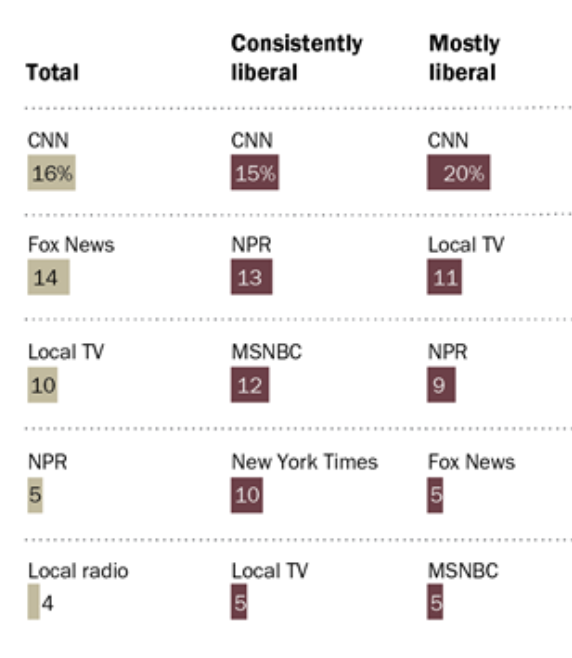
Source: Pew Research
When determining bias, some of the most common metrics used include Tone, Tendency, Author, Diction, and Expediency Bias, which are the primary metrics we’ll focus on below.
- Tone: This represents the attitude of the writing, formed distinctively but related to the author’s word choices or diction.
- Diction: The specific words chosen by the writer.
- Author: A metric related to the article’s author, taking into account their history of stance on issues based on past articles and social media posts.
- Tendency measures how consistently an author shows bias in their work, including factors like their tone and perspective.
- Expediency Bias relates to the immediate impression created by elements like the article’s headline, images, or summary, indicating if they favor a particular viewpoint.
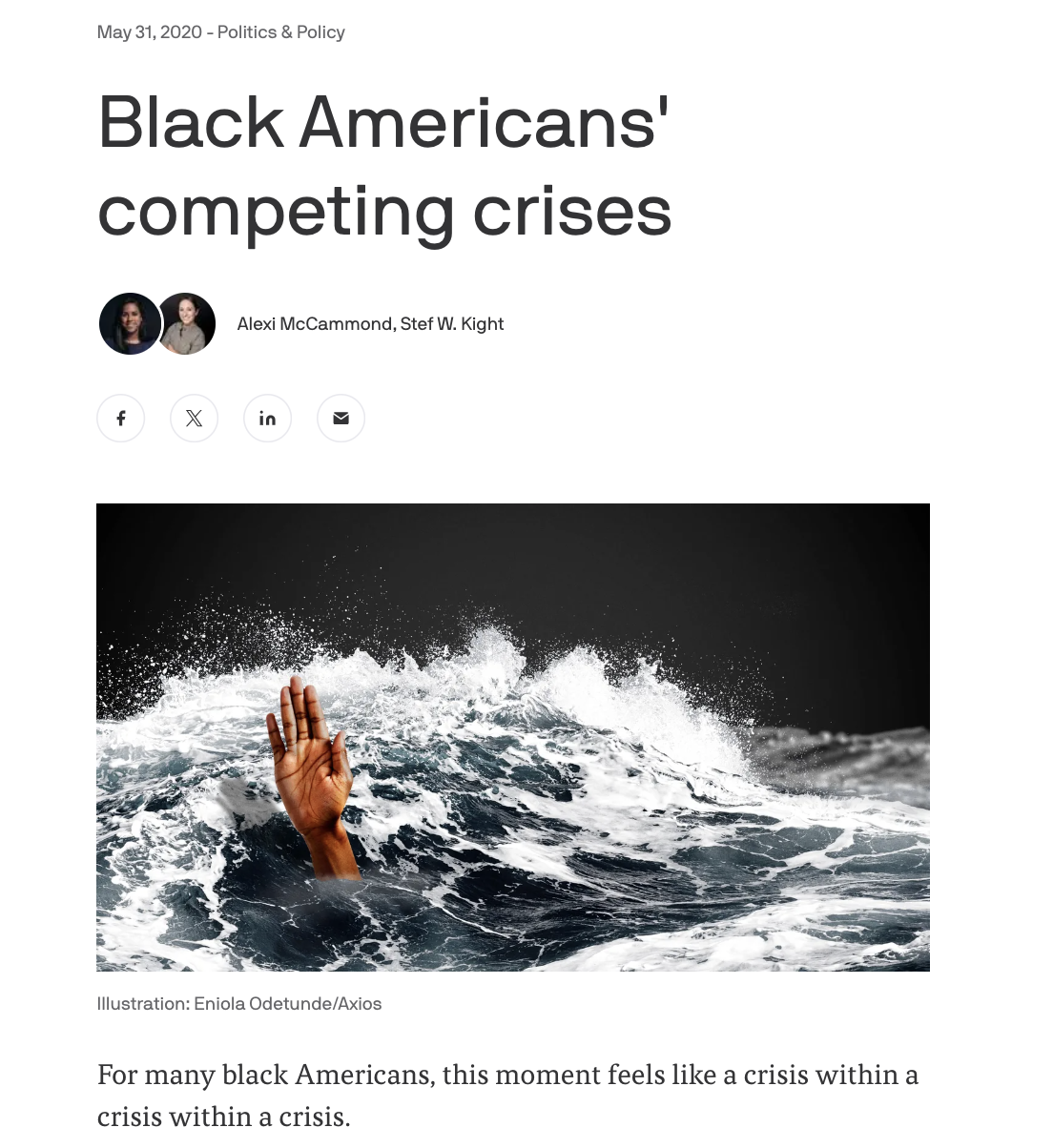
Source: Axios
An article we will examine is titled “Black Americans’ Competing Crises”. The title of the article generalizes the crises amongst Black Americans as a shared experience for the race. The caption under the image emphasizes the apparent issues Black Americans are facing. The language used illustrates desperation and problems that seem to have no end in sight. The image correlates with the diction used in the caption. According to Axios, the crises Black Americans face are simultaneous, thus creating a feeling of drowning in issues.
Biasly has rated this article as very liberal. The Tone rating has influenced Biasly’s rating on this article. Throughout the article, the authors focused on Black Americans facing violence and death at the hands of police with very extreme language.
“But if you leave the house, you open yourself up to new worlds of risk, including from law enforcement that are supposed to protect you.”
“It is coldblooded to expect any group of people who are being constantly terrorized, brutalized, and killed by police officers to never react in violent rage,”
The tone in the article paints a bleak picture of life as a Black American who faces multiple threats to their well-being. Using this tone serves to show the reader that Black Americans are truly struggling and are at constant risk of violence by police. It implies that all police are out to hurt Black Americans and have no remorse or empathy for their actions. Stating that the violence is constant pushes the narrative that American police are ALWAYS out to inflict violence and pain on Black Americans, which is not the case.
The article has a tendency to lean into left-leaning views on race in America. In general, the author’s often used statistics and talking points that fit left-leaning narratives on race. They explored ideas of healthcare inequality based on race and used quotes to demonstrate that African Americans are struggling with multiple problems simultaneously.
This method of writing showed a constant tendency to appeal to left-leaning readers who have concerns about race relations in America. The authors focus on the relationship between policing and Black Americans. Combining issues of police violence with health inequality and the economic state of the Black American population further leans into left-leaning views.
“If you’re a person of color wearing a mask, you may be viewed differently by store clerks or police than a white person.”
“But if you don’t wear a mask, you may jeopardize your own health as well as the health of others — or risk a penalty for violating social distancing rules.”
This quote shows how health issues are combined with the issue of policing. Written during the COVID-19 pandemic, Axios implies that Black Americans who are taking care of their health by wearing a mask are also at risk of experiencing police violence compared to a white person wearing a mask. Explaining the trade-off between wearing a mask or being at risk of police violence is Axios’ attempt to emphasize the racial significance of these problems. The authors try to justify the claim later in the article. They write about a statistic which concludes that Black Americans are twice as likely to be shot by police compared to whites. Furthermore, they mention another statistic comparing the disproportionate COVID-19 death rates between blacks and whites. The addition of these statistics shows their attempt at justifying their claim. The discussion of how violence and disease hurts African Americans more than White Americans is the authors’ justification that there is a supposed trade-off. To them, the trade-off represents the racial significance of policing and healthcare issues.
Strategic use of diction can further add to possible bias in articles. The stronger the diction, the more likely it is that the reader will be moved by their emotions when reading an article. The authors of this article had instances where they used strong diction. This was especially noticeable when they discussed the consequences of issues faced by Black Americans.
“But if you leave the house, you open yourself up to new worlds of risk”
“People who are already left behind are now facing even greater (and sometimes fatal) blows to daily life”
“We are living in two Americas”
Use of such diction is meant to create a reaction from the reader. In this case, the authors hope to create a sense of sympathy and anger towards the situation African Americans face. In these quotes, the author paints a bleak picture about life as an African American. Using words like “risk” and “fatal” in this context evoke a sense of desperation. The diction in the article aims to have readers think that African Americans face danger in their every-day routine. Through this, they side with left-leaning views on race. It could evoke emotions out of the reader which can move them to support the authors’ stance on the issue.
When examining the backgrounds of the authors, the online presence of Stef W. Knight shows her reposting the work of other journalists. These works covered headlines regarding elections and Congressional news with no bias detected in the headlines. The same can be said for the second author, Alexi McCammond. Her online presence shows her retweeting the work of other journalists in order to supplement her reporting on current issues. Today, her position is as an opinion editor for the Washington Post and a political analyst on MSNBC. Considering the left-leaning tendency of both news sources, there is a connection between where she works and the liberal bias of her article.
The author’s background and their online presence plays a role in Biasly’s rating of the article. We take into account their activity online which includes stances on issues and social media posts. Both authors maintain an online presence which can provide insight into possible political biases. Stef W. Knight’s online presence consists of retweeting and promoting articles written by other journalists. These articles had headlines which covered elections and Congressional news with no signs of political bias. For example, she tweeted three images showing a statement released by Senator Rick Scott. In the tweet, she adds a simple headline stating that the Senator is seeking to become the next Republican leader in the Senate.
NEWS: Sen. Rick Scott announces bid for Senate GOP leader in letter to colleagues
Says the position should be term-limited to 6 years pic.twitter.com/QCx8XIokRd
— Stef Kight (@StefWKight) May 22, 2024
The article’s second author, Alexi McCammond maintains a different online presence than Knight. She also retweets the work of other journalists if it relates to the issues she reports on. However, there is an instance of a retweet showing possible left-leaning bias. The tweet highlights a New York Times opinion article discussing the extent to which Donald Trump is a threat to democracy. The original author of the tweet says that the article covers this topic through “bothsideism”. McCammond’s retweet of this opinion shows she disagrees with the way the article was written, suggesting that she would rather see it written more against Trump. The idea of Trump being a threat to democracy is a viewed shared by left-leaning individuals McCammond’s retweet demonstrates her public stance and affirms her political leanining shown in the article.
More misleading stuff from one of resistance Twitter’s favorite accounts. This is a pretty standard liberal op-ed about how Trump has shattered norms in a dangerous way that threatens the integrity of America’s systems. But for engagement, it’s presented here as bothsidesism. https://t.co/pFTGUB8YRB
— Max Tani (@maxwelltani) May 31, 2024
It is important to note that McCammond has left Axios and currently is an opinion editor for the Washington Post and a political analyst for MSNBC. Considering the left-leaning nature of those two outlets, there is a possible connection which explains the liberal bias of this article.
Both authors attempt to explain to the audience that African Americans faced multiple crises during the COVID-19 pandemic and were at a crossroads. It was clear that they faced issues in healthcare and conflicts with policing. However, their tone skews the information to cater to left-leaning readers.
News outlets can have articles that vary in bias. A different Axios article, titled, “Congress’ partisan divide on paid family leave”, is an informational article that focuses on the facts of the issue. The author, Jacob Knutson, explains the chronological events that have occurred in Congress that have led up to this inflection point. He explains how both parties are approaching the idea of paid family leave.
“Democrats back creating a federal fund for new parents that would be financed with a payroll tax increase”
“Republicans have proposed plans that would allow new parents to dip into their future federal benefits.”
Once introducing the stances and solutions to the reader, Knutson explains that there is a bipartisan bill. He does not deliver an opinion about which solution is better. Rather, he writes that the bill is based on child tax credits and does not match the idea Democrats have proposed. According to Biasly analysts, the tone, tendency, diction, author, expediency, and accuracy were rated as zero or neutral. Their rating supports the content of the article and its ability to deliver political news with no bias.
Analysis of Axios Opinion Articles
Opinion articles are published by many news organizations, including Axios. Opinion articles allow authors to write about their personal views on current issues. The opinion articles are written by guest authors from different backgrounds. One example will cover the work of Matthew Ridenhour, a Marine Corps veteran from Charlotte, North Carolina.
Ridenhour’s op-ed, “I’m a Marine Corps veteran. Now I understand why people kneel for the anthem” explains his thoughts during the 2020 protests following the death of George Floyd while in police custody. According to Ridenhour, the founding fathers’ vision of “A More Perfect Union” needed more work as shown by the protests. He writes about how he as a white man does not need to worry about looking dangerous or thinking about being arrested while doing errands. In contrast, Ridenhour explains his realization that African Americans face the opposite situation.
This Axios opinion article shows the company values the insights of authors. They welcome different viewpoints but may lack full acceptance of works that conflict with left-leaning articles they have previously published.
Who Owns Axios?
Axios is a subsidiary of the privately held Cox Enterprises. When launching, Axios received investments from NBC News and the owners of Atlantic Media. The company does have other holdings which include major cable television provider Cox Communications. Cox Enterprises is owned by the Cox family and is operated by James C. Kennedy and Alexander C. Taylor. The Cox family traces its origins back to the governor of Ohio, James Cox, a Democrat. When he passed, control moved to his three children. While there is no reporting on the political stances of Cox’s children or those currently controlling the company, there can be assumptions about their political stance based on the background of their founder.
Currently, Axios’ CEO is Jim Vandehei with Roy Schwartz serving as President. Mike Allen is the executive editor. These three are also the founders of Axios. Jim Vandehei’s career consisted of working at the Washington Post and helping create Politico. Mike Allen has worked for Time, The New York Times, and Politico. There is no information regarding their political affiliations aside from where they have worked.
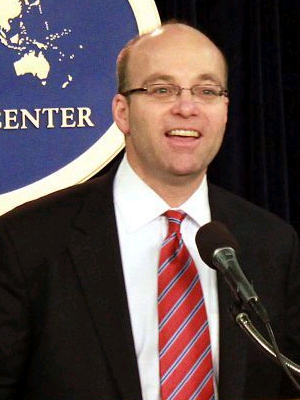
Source: Wikipedia
Considering the background of Axios from its start to being a subsidiary of a cable company, it is easy to see the origins of its left-leaning work. A founder with Democratic roots and investors who are seen as left-leaning supports the conclusion that Axios will favor left-leaning ideology and causes through its publications.
How to Evaluate and Uncover Bias
It can often be difficult to tell if the news you watch is biased. If you have settled on a news channel, it’s usually because you trust the information you are gaining. Unfortunately, many trust the information they are hearing because it confirms what they already believe. This is referred to as “confirmation bias.” It is important to challenge your beliefs and get third-party verification that what you are hearing is the full story. This is why we recommend using Biasly to compare different news stories side-by-side using our bias ratings to figure out what both sides think of a political issue.
The appearance of bias in news can vary depending on the author or objective of the article. Axios represents both sides of news reporting. Although Biasly rates Axios as somewhat liberal, there are instances where Axios has shown it can publish neutral works about politics. On the other hand, there are articles that cater to Axios’ bias and try to appease their target audience. The changes in bias is why it is important to use Biasly’s News Check to see if an article provides accurate and unbiased news.
For one of the articles below, let’s add a paragraph about the author and show their Twitter posts so we can see what kind of leaning they have
I have the paragraph below but for both authors their tweets are mostly links to articles and nothing that stands out. There is one tweet from McCammond that shares an op-ed and in the tweet she says that Trump is “one candidate is viewed as a threat to democracy” I am not sure if that is the best example to show bias but if it is I can add it. Just wondering if I should go about adding it or not.
Yes that is a good one to add. Please add the tweet embed code in the doc and a paragraph to introduction the author rating and analysis. You can look at other tweets and also articles.






















